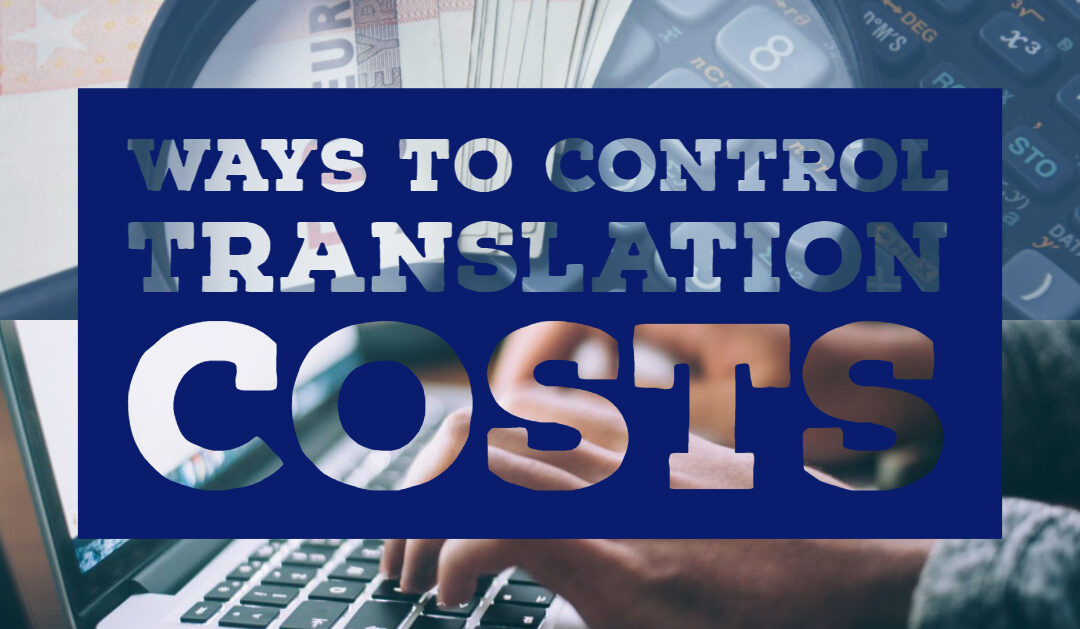[vc_row][vc_column][vc_column_text]There are many ways to save money on translation services for your company. There are a few general tenets to follow if you want to save money on translations, from preparing your document to summarizing parts for the translator. There are also more in-depth ways to cut translation costs significantly using only a few tips. Hopefully, these little tips give you an increase in your translation quality while saving you money.
How to Prepare a Document to Save Translation Costs
You’ll want to start by deleting all excess empty spaces out of the document to be translated. Most translation programs set the cost of the translation by line, by word or by characters. You’ll want to trim the excess empty spaces to save a little bit of money on the translation. You’re not going to save a fortune, but you might save a few dollars per document.
Companies should also send an editable document to the translation agency. Companies that send a PDF might be hampering the translation and editorial process. Turn around times might be affected if your submitted text is not editable. Time is money. You’re going to get the translation back quicker if you send an edit-ready document.
Another important point is that translation agencies want the source files in a particular format. The time they use to convert your document is a cost they’re willing to pass on to you. Translation customers expect their documents to get translated while retaining the formatting one hundred percent. The easiest way for the translation company to do this is to have your company give them an appropriately formatted document. [/vc_column_text][ult_buttons btn_title=”Tweet About How To Prepare A Document To Save On Translation Costs” btn_link=”url:https%3A%2F%2Fctt.ac%2F4gc7Y|||” btn_align=”ubtn-center” btn_title_color=”#ffffff” btn_bg_color=”#dd9933″ btn_bg_color_hover=”#81d742″ icon_size=”32″ btn_icon_pos=”ubtn-sep-icon-at-left” btn_font_size=”mobile_landscape:15px;mobile:15px;”][/vc_column][/vc_row][vc_row height=”small”][vc_column][vc_column_text]
Make Sure You’re Only Translating Valuable Information
Companies can also use a summarizing and pre-editing workflow to gain translation cost savings. Imagine a company has a document needs to be translated into 20 languages. They also know that some of the content might not be so relevant. A good editor in your company can reduce this document using summarization as well as removing superfluous words and sections. A small percentage reduction in the source text can pay off if it’s going to be translated into 20 languages.
Saving on Translation – Tips on Getting a Quote
Many factors go into getting an accurate quote. If you don’t want to be overcharged for translations, you should ask for a discount for any untranslatable text in the work you’re submitting. These will often have pages full of numbers that don’t need to be translated. Anything that you point out as being redundant or extraneous in your document should give you a substantial discount. These concessions will reflect in the final price of the translation as everything you point out will help lower your cost.
Use a Translation Memory
The optimal translation process relies on a variety of elements to establish a consistent translation pipeline for the company. Two of the biggest ways a company can get translation cost savings is by the use of a term glossaries and translation memories. These two elements alone will cut costs significantly and lead to higher quality translations.
The translation memory is designed to capture previously translated phrases. These aren’t single words. It won’t be just a word like “cat” but rather a fuller phrase or sentence such as “I like playful cats.” If this sentence or sentence fragment has been translated in the past, your translation memory will kick in and tell the translation team that there’s a hundred percent match in the translation memory. A translation management system or TMS with translation memory features will need to be used. A good translation agency will use a TMS to help their clients cut costs and increase turnaround times.
Ask the agency to keep a translation memory on file for all your translations. A good agency will have a cloud service that will story translation memory and input it into a translation automatically. This is especially useful in saving your company money in the future. If there is a certain percent repetition in the document, you’ll be provided a discount. Translation memory attempts to match your source sentences to those sentences that are in your translation memories. The companies not only have to offer this feature, but they also have to have some linguistic knowledge to implement these memories. A translation agency normally doesn’t pay much (if anything at all) to their translators for the regularly repeating words in the document.
Use a Term Glossary
A term glossary is a list of words and the corresponding translations. You’d give the agency a set of words and phrases either relevant to your vertical or linked directly to your products and services. This will include words that you would like to use and give some continuity to your texts. Large companies often want to use the same descriptive words to describe their products. The benefit of a term glossary from the very beginning means that you are communicating your standardized language to the translator. This is so they don’t have to search for translations which would possibly deviate from those that you would like to employ.
The translator then imports these into a translation management system, also known as a TMS. The TMS is an excellent example of using translation technology to save on costs. The computerized system will then tell the translation team about the terms that have been previously translated to the destination language. This helps assist the translator, ultimately creating both a time and cost savings.
How Term Glossaries and Translation Memories Reduce The Cost of Translation
Employing both of these assets will not only lead to time and cost savings. You also achieve a great synergy with a term glossary working with a translation memory. These two in conjunction lead to an increase in translation quality. The term glossary makes sure that your words are used as the customer will understand them. Using a robust translation memory ensures that there is language continuity. This is important as your most recent translations are going to be similar to the translations that have been used in the past.
Save on Proofreaders
All translators use both the glossary and the translation memory together with a proofreader. All language translations are proofread before the customer gets them. You should ask where all the translations are being sent to be scanned by editors. If the company employs various proofreaders according to the target language, perhaps there’s a way to save on proofreading costs. If your translated French documents are only going to circulate in Quebec, then you probably don’t need to send your document to a proofreader in France. If your translation agency offers different rates according to whether the proofreader is in the world, this is a good opportunity to cherry pick which languages are best proofread domestically.
If you do all of these steps, you’re going to have very high-quality translations. As you’re reducing the costs, you’re also increasing the quality by getting rid of extraneous things that complicate and block the workflow. Companies should put their focus on things that will make a big difference in cost savings and the quality of the final translation. Things like a term glossary, translation memory, and proofreader choice are all important parts of saving on translation. Translation agencies also have years of experience using translation technology to save on costs.
Don’t Stay In-house If You Can’t Handle It
When a company is trying to optimize their translation workflow, they might consider fulfilling their translation in-house or using an outsourced approach. An in-house approach might appeal to certain businesses that feel up to the job. A translation project not always as easy as it seems. There are many other costs that are often overlooked when taking the translation in-house. An agency will also use translation technology like a translation management systems (TMS) to help streamline translation projects to save time and money.
Companies also have to consider other costs including the effect on project time. The project time might expand if it takes to long to complete the translation project. This can potentially have a negative impact on the company’s performance. An in-house translation job also means that a company resources are being used for translation that could’ve been used elsewhere. There’s only a finite amount of staff available to deal with day to day business. Companies often misjudge all the parts of the translation process. These various unfamiliar procedures could make it hard to deliver a quality translation while staying on schedule.
Playing With Time and Money Budgets
Translation agencies love to hear the phrase “I need the translation as soon as possible!” If it’s urgent, they know they can charge you more for a rush job. Companies should have a streamlined system so as many documents as possible are given to the translation agency with sufficient lead time. Failing to do so will send a larger percentage of your documents into the “urgent” category. If a translation is not urgent, don’t mark it urgent. It’s probably going to end up costing your company more money.
You also should set a budget and stick to it. An agency will quote you the lowest amount possible while remaining within your translation budget. Translation agencies are also willing to go low on a bid if you are a first time customer. They know that if they do a good job, they can win your business in the future.
It is a lot of work to create things like a term glossary. No one is excited to write down all these words and all of the corresponding descriptions. It turns out that there are software systems available for extracting glossary from the already created documentation. This type of software is an elegant solution for parsing documents for terminology extraction. Companies may need help from their translation agency to set up cost-saving measures like a term glossary. But little steps like these are well worth it to minimize the overall cost of translation.
Get a high-quality translation at the best rate with inWhatLanguage.
“Very professional team and service done early or on-time.” – Nan Ross
[/vc_column_text][ult_buttons btn_title=”I Want To Save Costs On Translation” btn_link=”url:https%3A%2F%2Finwhatlanguage.com%2Ffree-quote%2F|||” btn_align=”ubtn-center” btn_title_color=”#ffffff” btn_bg_color=”#dd9933″ btn_bg_color_hover=”#81d742″ icon_size=”32″ btn_icon_pos=”ubtn-sep-icon-at-left” btn_font_size=”mobile_landscape:15px;mobile:15px;”][/vc_column][/vc_row]





Recent Comments